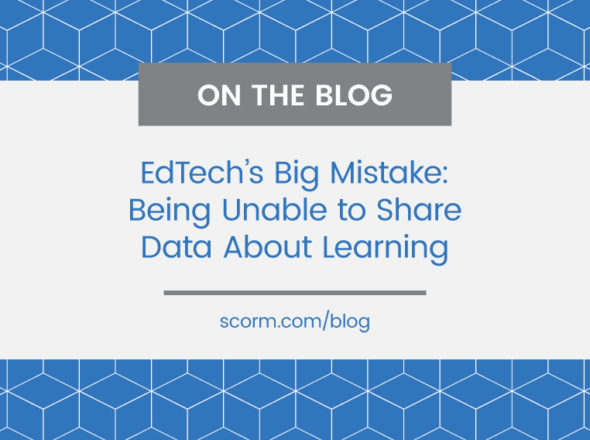Key Points:
- Training should not be bound to the browser or the network, desktop training, mobile training, and virtual worlds should be supported.
- LETSI RTWS meets most needs, authentication must be resolved.
- Multi-user training should be supported.
- LMS should not control everything, content should be able to identify itself and the learner to the LMS and track.
- Attempt history requirement of RTWS is useful
- Clients want to have everything in one place, ability to track multiple training sources back to a single system.
Let’s start with LETSI RTWS (Run Time Web Services) — what customer needs were those that led to you getting involved in that?
One of those needs is to take training to the next level without being bound to a browser or to the network, more than anything. I’ve seen a lot of issues with slow networks, slow performance, where there was a real need to disconnect but not completely. There was a need for offline training. More than anything, support for mobile devices, support for desktop applications, even virtual worlds. I’ve been trying to show them a lot of things that could be done with virtual worlds.
What have your customers been asking for in this area that RTWS doesn’t address?
At this point, at this moment, the authentication piece has to be completed in order for them to truly evaluate the process. So once we have the security on top of that, then it would be ready for them to try and look at it, and evaluate it seriously. Because right now we have to hard code session ID. Not so seamless, but that’s always needed. But I say that that’s coming on phase 2, the second phase run, next phase of the project. Other than that, I think what its offering, what brings to the table is exactly what they need at this moment.
Not just related to RTWS, can you see any other learning needs that are coming that might not even relate to what RTWS is doing, that in a new learning experience standard should be supported?
SCORM needs to be complicated to fulfill real needs, but its too complicated — it should be easier to understand, first of all. Second, I think there are too many data model elements, I think there should be a consultation for how much is required. We need to reevaluate “what is SCORM offering at this moment” — is it enough for what’s coming? I think the center needs to be thinned up a little bit. But that creates all the complexities, in the sense of vendors, LMS owners, course developers. You’ve seen LMSs support SCORM but they don’t really perform the way its intended. Now from the commercial perspective they don’t really care if it’s conformant or not, they just want their content running on whatever platform is being delivered. The average content developer really pretty much just uses SCORM 1.2. LMSs, they do whatever they want, as long as the content runs, as long as the client is happy, they don’t really care if they break the spec or not.
But we are really limiting to, “Here’s the SCORM, just work with it,” we are not letting them, have that imagination fly, see what you can do with that and how can you support it? For example, can you support virtual worlds, multiple users on a game, for example, in a virtual environment? SCORM is a one to one, one event per student and do we have multiple people with scores per student? We want to look into it — the only way that could be answered is by having pilots and having people use it and test it and have some kind of project implemented and see if it works. Now if you’re not in a browser, if you’re now on a handheld device or a virtual environment, then your content is not real content, your content are activities and events. So can you tie them to a SCO so you can track progress of activities or set of activities that our user can go through.
Since we’re currently tied to one SCO, maybe ideally a session would be for the entire package and you could then track to different SCOs within that package, which would no longer necessarily be a physical package, just saying these different SCOs are different lessons-
What I think would bring a lot of power is if the content could identify itself — “I’m in a SCO 7, and this is all the data for SCO 7,” and then you can have different activities in different places, they don’t have to be in a browser or be at a desk, they don’t have to be bound to traditional e-learning material. It could be anything. It could really be anything. That would give a lot of freedom for new innovation, new ideas, completely new ideas. You’d have more control with what is going on and not let the LMS think for everything, because right now the LMS has full control. That’s good, but let the content also identify itself in that way, you support multiple user environment or activity.
By letting the content identify itself and which user its tracking for.
That would be something to take it to the next level. But again, the data model should be revised and some of them taken out, or new ones added, or something more generic added.
One thing RTWS is responding to is the need to track attempts? And that’s something that I see a huge need for with the clients that I have. And that’s something that they want, something that we need, something that’s missing. There’s a hole there with SCORM. RTWS thought about that and that was one of the neat things about it. One of the things that I like the most of improvements. The first thing is the possibility of doing things synchronously. The second is the attempt, the keep the data for attempt, you know, one, two, three, four. And then the other big improvement was getting rid of the exit status and then just keep — instead of the terminate or whatever, you would combine all of those into just one instead of two. It just makes things more optimal.
What sort of other systems are you integrating with in regard to training, are you seeing a demand to, and I guess what I’m trying to get at here is — wanting to track everything, we see that data training information results would be able to come from just about anywhere, but where does it need to go?
Well, my clients are primarily government and they want to have everything in one place. They like everything in one place, one single point of entry for everything. So they want interactions with everything. Now, being government, they are a really formal tradition of secondary education or formal education, it’s just training. What they want to track more than anything, more than grades, or scores, is a person completed or not completed at training. Go or no-go kind of status of the trainee. So, I guess they want all kinds of integration, if they can connect, they are able to connect a learning event to a SCO for example, double-connect type of conference, connected to a SCO is something they would like to see, but I don’t know if they would use it.
I don’t know what can be integrated in SCORM. The thing is, I can see the benefit of having all these types of training put together. Having a hybrid of online content, virtual content, classroom content, or classroom delivery, like Dolby Connect type of events, all of them connected somehow. Not necessarily one specific content I make objective for the training. It’s like trying to get a certificate, becoming Oracle certified for example, and you have to fulfill course 1, 2, 3, 4, 5, and course 1 and 2 are online, course 3 and 4 are virtual environment, course and 6 are a Dolby connect type of session, a virtual session or something. Got to find a way to tie all the objectives for all these elements to one place and that’s why I’m saying product for the commercial LMSs probably have a better, more experience in doing that. They could probably bring some insight into how to do that. Or the schedule for doing that, or to say, oh it’s better to leave it alone, just SCORM content is SCORM content and never tied with anything else. If that’s the case, then tied with virtual world environments is not an option.


